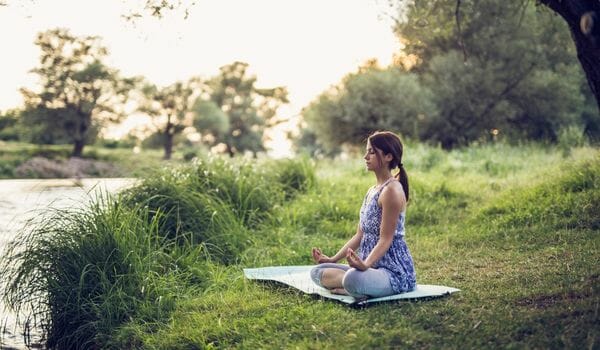Mindfulness In Action: Simple Exercises To Find Inner Peace
Do you ever feel like life is a never-ending cycle of stress and anxiety? Have you exhausted all the…

Do you ever feel like life is a never-ending cycle of stress and anxiety? Have you exhausted all the conventional methods to find inner peace, but still failed to achieve it? Well, fret not! The newest trend in town has got your back. I present to you – Mindfulness in Action: Simple Exercises to Find Inner Peace.
Yes that’s right; mindfulness exercises are here to save the day! With easy practices such as focusing on breathing or body awareness, these simple yet effective techniques can help soothe your mind and soul. Plus they don’t require any fancy equipment or expensive resources – just a few minutes of commitment per day. Sounds too good to be true? Read on further to discover more about this revolutionary concept.
Mindfulness is an ancient practice with modern applications, allowing us to recognize our thoughts without judgment and reconnect with ourselves in meaningful ways. This article will explore how we can use mindfulness principles for greater self-awareness and personal transformation in our everyday lives. We’ll look at different types of mindfulness techniques, their benefits, and even provide some tips on how to get started today! So let’s dive into the world of mindful living and open up a new door towards inner peace.
1. What Is Mindfulness?
Mindfulness is like a tranquil lake, surrounded by lush greenery and the soft embrace of serenity. It’s an oasis of inner peace to be found within us all. But what exactly is mindfulness? Mindfulness isn’t a complex concept; it’s simply the practice of being present in the moment and allowing ourselves to observe our feelings without judgement or attachment. In other words, it’s learning how to pause and take stock—to listen deeply to your own thoughts and feelings rather than getting swept away by them. This can help you better understand yourself while also creating more room for joyous moments in life.
2. Benefits Of Mindfulness
Mindfulness is a powerful tool that can help us find inner peace. But it’s important to understand what the benefits are before we start a practice. Developing an understanding of these advantages can be motivating and inspiring as we embark on our journey towards greater awareness.
The most obvious benefit of mindfulness is improved mental health through increased self-awareness and emotional regulation. Being aware of your thoughts and feelings helps you gain insight into how they affect your behavior, making it easier to make positive decisions in difficult situations. Additionally, mindfulness reduces stress levels by allowing you to take stock of the present moment without judgment or attachment. This makes it possible to respond calmly instead of reacting impulsively or emotionally when faced with challenges. It also gives us the opportunity to cultivate gratitude for all the good things going on around us, which improves our overall mood and outlook on life.
These two aspects – being mindful of yourself and being grateful – combine to form the foundation of a successful mindfulness practice. By doing so, we open ourselves up to new possibilities for creating moments of stillness and clarity within our lives – moments where we can feel more connected to ourselves, others, and even nature itself!
3. Developing A Mindfulness Practice
Mindfulness is like a soft breeze that soothes the soul and brings inner peace. As we continue to explore mindfulness, our journey takes us to developing a practice for ourselves. This process involves dedication and commitment as it requires one to be present in every moment of their life with an open heart and mind. To help guide you on your path, here are five steps:
- Start small – taking just 5 minutes per day to practice mindful breathing or meditation can have a major impact over time;
- Make it part of your routine – choose certain times throughout the day where you will pause and be mindful;
- Find what works best for you – there are many ways to embrace mindfulness such as walking, journaling, drawing, etc.;
- Be patient with yourself – this is not a race but instead a journey towards understanding oneself better;
- Reach out for support when needed – connecting with friends or professionals who understand mindfulness can provide guidance along the way.
As you begin to immerse yourself in your own mindfulness practice, remember that each step forward is progress regardless of its size. With time and focus, you will naturally move closer towards achieving greater harmony within yourself. Making these changes from the inside-out allows us to connect deeper into our true selves and discover new paths of exploration ahead.
4. Guided Mindfulness Exercises
Moving on from mastering a mindfulness practice, the fourth step is to explore guided mindfulness exercises. Practicing with guidance provides an added layer of support and assurance that allows for greater inner peace when engaging in mindful moments. These carefully crafted sequences lead participants through physical, mental, and emotional states to help cultivate awareness as well as relaxation.
Guided meditation can take many forms; from progressive muscle relaxation to visualizations or simple breathwork. All these methods are designed to increase focus and concentration, reduce stress levels, and bring about feelings of calmness and tranquility. Experienced meditators often find it easier to settle into a peaceful state by following along with someone else’s words or instructions than by trying to go at it alone without any prompts. With each exercise comes growth which leads one closer towards their desired goal of inner peace and understanding.
5. Identifying And Challenging Negative Thoughts
As ironic as it sounds, negative thoughts can be quite a positive thing. For one, they remind us of the power we have over our own minds and how we are capable of transcending any difficulty. But if left unchecked, these same thoughts can also lead to feelings of anxiety and despair. That’s why identifying and challenging negative thoughts with mindfulness is key for finding inner peace.
In this exercise, you will learn how to recognize your own negative thought patterns, identify their triggers, and challenge them with mindful awareness. This process helps break down irrational beliefs and habitual thinking that keep us stuck in unhealthy cycles of negativity. It also provides an opportunity to look at ourselves objectively and reflect on whether or not those thoughts are actually true or helpful in any way. Once identified, you can then start replacing those destructive ideas with more rational ones – allowing yourself to move forward with greater clarity and understanding.
We’ve reached the end of this section of guided mindfulness exercises but there is still much work ahead: practicing mindfulness in everyday life is essential for long-term inner peace. Let’s take a deep breath before embarking on this journey together!
6. Practicing Mindfulness In Everyday Life
Now that we have identified and challenged our negative thoughts, it’s time to look at how we can apply mindfulness in everyday life. Practicing mindfulness is an ongoing process as it requires dedication and consistency. Let’s explore the ways in which you can incorporate this practice into your regular routine:
• Make a conscious effort to be aware of each moment – We often get caught up in our own thoughts and worries without even noticing what is happening around us. Making a conscious effort to observe the present moment will bring more awareness and inner peace.
• Take breaks throughout your day – Stopping for five minutes here or there during the day will allow you to take some time for yourself. You could use these moments to meditate, enjoy nature, or just relax by taking slow deep breaths.
• Learn from difficult situations – Difficulties are part of life, but they can also offer opportunities for growth if viewed with the right mindset. Whatever situation arises, try not to react immediately; instead pause, breathe deeply and search within yourself for a response that comes from a place of calmness rather than reacting out of fear or anger.
By making small changes like these over time, you’ll begin to notice improvements in your overall wellbeing as well as relationships with others. So don’t give up on yourself! With patience and dedication, mindfulness can become second-nature allowing you to live peacefully no matter what circumstances arise in life.
Frequently Asked Questions
How Long Should I Practice Mindfulness For Each Day?
Mindfulness can bring a great sense of inner peace, but how long should it be practiced each day to maximize its effects? According to research from Harvard Medical School, 68% of people who practice mindfulness for 20 minutes every day over 8 weeks experience an increase in wellbeing and overall mental health.
So let’s take a closer look at the benefits of daily mindfulness practices and how you can get started:
• Benefits: Practicing mindful meditation regularly has been shown to reduce stress, improve concentration, enhance emotional intelligence, and promote contentment.
• Starting Out: If you’re new to mindfulness, try setting aside 10-15 minutes per day for simple exercises. You could start by focusing on your breath or body sensations while being aware of any thoughts that come up during this time. As you become more comfortable with these types of meditations, gradually lengthen your sessions until you reach the recommended 20 minute mark. Additionally, if possible it’s best to practice at the same time each day as this helps establish a routine which may make it easier to stick with your practice longer term.
By making mindful meditation part of your daily routine, you’ll soon reap the rewards associated with greater inner peace and improved mental health. What better way is there to begin caring for yourself than through taking some moments out of every day just for you!
Are There Any Risks Associated With Practicing Mindfulness?
Practicing mindfulness can be like a voyage of discovery – one that leads us to our inner peace and understanding. It is something we must commit to daily, but it comes with its own risks.
The practice of mindfulness has been linked to increased stress levels in some individuals. This happens when they become overwhelmed by their emotions or thoughts while trying to stay aware, resulting in an inability to cope and even exhaustion. To avoid this pitfall, it’s important to set realistic goals and expectations for yourself when practicing mindfulness. Start small and gradually build up your timeframes as you become more comfortable with the practice.
It’s also important to monitor how you are feeling throughout each session; if at any point during your meditation you start feeling anxious or distressed, take a break from your practice until you feel better. Finally, although there can be positive benefits from mindful practices such as improved focus and clarity of thought, make sure not to overdo it; moderation is key here so ensure that you don’t spend too much time on any single activity.
Taking these precautions will help keep your mindfulness sessions safe:
- Make sure to check in with yourself regularly: Notice how you’re feeling before, during, and after each session.
- Set realistic goals for yourself: Don’t try to do too much all at once! Take things step by step.
- Understand the balance between effort and ease: Aim for moderate intensity—not too intense nor overly relaxed – so that you’ll get the most out of every session without becoming overwhelmed.
- Monitor any physical sensations: Pay attention to changes in body temperature or tension levels which may indicate an underlying emotion or discomfort that needs addressing before continuing meditation.
Mindfulness requires patience and dedication if we want to experience its true potential – but proper care should always come first! Taking the necessary steps now will put us firmly on track towards achieving a steady state of calmness within ourselves.
How Can I Incorporate Mindfulness Into My Lifestyle?
Mindfulness can be a powerful tool for finding inner peace, but how can you incorporate it into your lifestyle? There are many ways to do this, and the best way is to start small. Begin by setting aside time each day – just five minutes or so – to practice mindfulness exercises. These could involve focusing on your breath, or simply sitting in stillness and observing any thoughts that come up. Be sure not to judge what comes up – instead, try to observe without attachment.
Once you’ve established a regular meditation routine, it’s important to bring mindfulness into everyday life too. This might look like being mindful of how you talk to yourself throughout the day; paying attention to the sensations in your body during moments of stress; or even noticing when negative thinking patterns arise. The key is to remain aware and present with whatever arises, recognizing it as temporary rather than attaching too much meaning to it. With practice, these simple exercises can lead us towards greater self-awareness and inner peace.
Does Mindfulness Have Any Scientific Backing?
Can mindfulness really bring about inner peace? It’s a question that many of us have asked ourselves at some point. In an age where science and technology rule, it might seem like an ancient practice with little to no evidence to support its claims. But the truth is, there’s actually a great deal of scientific backing behind this centuries-old practice.
Mindfulness has been studied extensively in recent years by neuroscientists, psychologists and psychiatrists alike. Research has shown that regular mindfulness practices can help reduce stress levels, improve focus and even increase compassion towards others. Studies have also revealed how mindful meditation helps change brain activity patterns, leading to improved mental clarity and emotional balance.
The power of mindfulness lies not only in its ability to provide relief from everyday stresses, but also in its potential to create lasting changes in our lives. By allowing us to take time for reflection and self-care, we can become more aware of our thoughts and feelings – creating the space needed for real transformation to occur. With consistent effort over time, these subtle shifts can lead us on the path toward true inner peace.
Is Mindfulness Suitable For People Of All Ages?
Mindfulness is a concept that has been around for thousands of years, yet it still remains relevant to this day. It’s increasingly becoming popular with people of all ages – from the very young to the elderly – as an effective way to reduce stress and find inner peace. But how suitable is mindfulness really for everyone?
When looking at the scientific backing behind mindfulness, we can see that its benefits are far-reaching. Research suggests that it can improve physical health, mental wellbeing and overall quality of life in both adults and children alike. Specifically, here are four key ways in which mindfulness may be beneficial for people of all ages:
- Enhancing focus by tuning out distractions;
- Alleviating stress levels through deep breathing exercises;
- Cultivating compassion towards yourself and others; and
- Increasing self-awareness to better understand your emotions.
These results have provided evidence suggesting that mindfulness is indeed suitable for individuals of any age – regardless of background or lifestyle. So if you’re looking to bring more peace into your life, why not give it a try? There’s no harm in taking on some simple exercises such as mindful walking or focusing on your breath!
Conclusion
In conclusion, mindfulness can help us find inner peace and improve our overall wellbeing. It’s an effective way to take care of ourselves and gain more control over our thoughts and emotions. My research suggests that regular practice of mindful exercises is key to getting the most out of this ancient technique.
Research indicates that the average person who practices mindfulness for 15 minutes per day sees a reduction in stress levels of up to 25%. That’s pretty impressive! This statistic not only shows how powerful mindfulness can be but also highlights its potential for helping people cope with mental health issues such as anxiety and depression.
All in all, it seems that there are many benefits associated with practicing mindfulness on a regular basis. It doesn’t matter what your age or background is; anyone can benefit from giving themselves some time each day to focus on their internal landscape. I hope I’ve been able to provide you with enough information so you feel confident about taking those first steps towards inner peace by incorporating mindful activities into your lifestyle.





